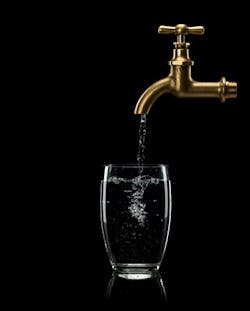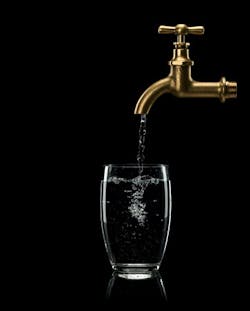By Alanna Maya
Never has there been a better time than now for technology and water quality to intertwine. With news of lead lines contaminating water supplies in Flint, Mich., and Sebring, Ohio, sparking similar investigations in towns across the country, the topic is, quite literally, on the tips of everyone’s tongues. Across the globe, twice the population of the United States lives without access to safe water; one in nine lacks access to clean drinking water.1
Solutions to the global water crisis that can truly stand the test of time are at an all-time premium. Thankfully, there are numerous innovations that represent creative ways to solve the water crisis by developing new techniques, maximizing efficiency and sometimes even producing drinking water from thin air. Here are a few that caught our eye.
Water Out of Thin Air
Imagine being able to produce water simply by extracting humidity from the air. A few companies are perfecting technology that does just that. Ambient Water’s AW400, for example, is an atmospheric water generation system that can produce anywhere from 300 to 600 gallons of clean drinking water per day. It can be installed nearly anywhere there is a power source and relative humidity of at least 40 percent.
Once the air enters the system, it is chilled to its dew point, and the moisture is condensed onto special stainless steel or coated coils, then channeled through advanced filtering chambers. Through mechanical filtration technology, the water is purified and immediately ready to drink.
“Most sterilizing systems use UV lights to inhibit bacterial growth,” Ambient Water CEO Keith White said. “This uses a lot of energy, and cannot inhibit bacterial colonies from growing inside any tubes or piping.”
The AW400 uses a combination of an activated carbon filter and HaloPure filters from HaloSource, resulting in water that is 99.9 percent free of impurities on the back end.
The company’s technology was recently on display at the University of California - San Diego (UCSD), where it will be used by research teams focusing on engineering, sustainability, and water conservation.
The technology is extremely scalable, added White, noting that multiple units can be “daisy-chained” together to provide bulk water supply where needed. Currently, a proposal exists to augment water infrastructure in Latin America with the technology, though its applications are seemingly endless and include hospitals, disaster response and as a community drinking water source.
Another method of extracting water from the air does so by harnessing water molecules from fog. Fog harvesting technologies use giant nets that trap the moisture and funnel all of the tiny droplets into a container. Unfortunately, most existing systems allow a lot of water to slip through the cracks. Traditional nets, for example, are woven out of polyolefin mesh, a kind of plastic with large pores. However, improvements to this technology from MIT promise five times more water generation simply by adjusting the netting material.
According to a press release, researchers found that the best performance comes from a mesh made of stainless steel filaments about three or four times the thickness of a human hair, and with a spacing of about twice that between fibers. The mesh is dip-coated using a solution that decreases a characteristic called contact-angle hysteresis. This allows small droplets to more easily slide down into the collecting gutter as soon as they form, before the wind blows them off the surface.
The system is currently deployed in the coastal mountains of Chile at the edge of the Atacama Desert, yielding a few liters of drinking water per day for each square meter of mesh, though the theoretical calculations show that newly designed systems operating at certain times of the year (stronger wind, denser fog) could yield up to 12 liters per day or more.
The researchers suggest that large mesh structures could be set up relatively inexpensively and, once in place, would cost virtually nothing to operate - only occasionally needing brushing to remove particles.
Who Said Water and Electricity Don’t Mix?
Cost and infrastructure requirements can sometimes be a barrier to utilizing desalination. But MIT researchers have devised a new alternative to traditional desalination technology that could help address those challenges. The process is called shock electrodialysis, whereby an electric shock is introduced to a stream of flowing water.
The treatment does not rely on barriers to strain sodium particles from water. Instead, it uses a “frit” - porous material made of small glass particles - with electrodes attached to the sides. When a charge is applied, water with higher salt content begins to separate itself from the sodium-depleted water. When the electrical current reaches a certain point, the water flow breaks into two channels. The fresh water can then be collected and used.
The system not only removes salt but also other contaminants, and because an electrical current passes through the stream, it may also sterilize the water in the process. Because the “filter” in the treatment process is relatively inexpensive (glass), the scalable nature of the technology could greatly impact the world water crisis.
“Unlike some other approaches to desalination, this one requires little infrastructure, so it might be useful for portable systems for use in remote locations, or for emergencies where water supplies are disrupted by storms or earthquakes,” graduate student and research team member Sven Schlumpberger said in a statement. Though the technology has only been produced in a lab, the next step is to scale the system for practical testing.
But MIT isn’t the only university getting in on the action. Also using electricity to take the salt out of water, researchers from the University of Texas at Austin and the University of Marburg in Germany have developed a “water chip” that creates a small electrical field that separates salt from seawater. The technology, which is still under development and works at the nanoscale, uses so little energy it can run off a store-bought battery. A 3.0 volt electrical charge is applied to the plastic water chip, which has a microchannel with two branches. This reaction creates an “ion depletion zone” with an embedded electrode that neutralizes chloride ions, thus redirecting the salts in the water down one channel, while the fresh water goes down another. Currently, the technology purifies just one nanoliter at a time and only has a 25 percent efficiency rate, but a small startup called Okeanos Technologies has been tapped to improve and then scale up the process.
“We have contemplated building a small system that would look like a Coke machine and would operate in a standalone fashion to produce enough water for a small village,” Tony Frudakis, head of Okeanos, said in a statement.
A New Type of Membrane
The latest in membrane technology could be as close as the pencil on your desk. Baoxia Mi, an environmental engineer at the University of California - Berkeley has worked on developing a more cost-effective and efficient membrane for water purification using tiny layers of graphene oxide, a compound derived from graphite.
The layers, 100,000 times thinner than a strand of human hair, are separated by spaces specifically designed to remove certain contaminants. By playing with the spacing between the layers, these filters could potentially remove any water contaminant. These “nano filters” are currently in development, but could be commercially available in a few years.
Looking Ahead
While these technologies are a good starting point, the demand for solutions to the world’s water problems remains. However, the path from idea to fruition can be difficult to navigate. To this end, there’s been a rise in innovation accelerators that foster technological innovation through mentorship, workshops and capital investments. The CleanTech Open, for example, has launched a new program, CTO-H2O. It’s a six-month accelerator program that supports water-technology startups and helps them get to market. This year, the organization expects to support 30 startups through the program.
The U.S. Environmental Protection Agency’s grant program has also awarded hundreds of thousands of dollars to support research projects that aim to fix our nation’s water problems. One example is a $329,650 award for research into the microbial risk and sustainability of potable reuse systems. The research is intended to demonstrate that planned potable reuse offers a safe and sustainable alternative to conventional drinking water practices, by examining the risks associated with various treatment plans currently in place.
And there are many more projects on the horizon, proving that a little outside-the-box thinking can go a long way to solving the world water crisis.
References:
1. United States Census Bureau Estimates. (2015). United States and World Population Clock.
About the Author: Alanna Maya is the assistant editor for WaterWorld and Industrial WaterWorld magazines. Reach her at [email protected].
More WaterWorld Current Issue Articles
More WaterWorld Archives Issue Articles
About the Author

Alanna Maya
Chief Editor
Alanna Maya is a San Diego State University graduate with more than 15 years of experience writing and editing for national publications. She was Chief Editor for WaterWorld magazine, overseeing editorial, web and video content for the flagship publication of Endeavor's Water Group. In addition, she was responsible for Stormwater magazine and the StormCon conference.





